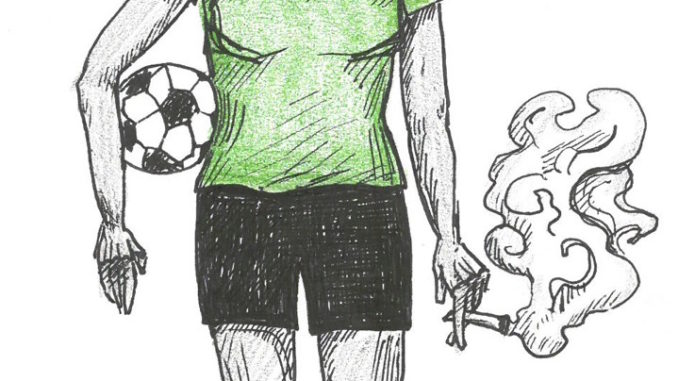
By Nicholas Nerli
Across the United States, advocacy for the legalization of marijuana has steadily liberalized public opinion of the plant’s use as a drug, making drug reform a common item of national debate. Currently, nine states have authorized recreational marijuana consumption while 29 states permit cannabis use for medical purposes. An October 2017 poll by Gallup showed that 64 percent of Americans now support the federal legalization of cannabis use, and Arcview Market Research expects the cannabis market to exceed $24.5 billion by 2021. The marijuana industry is booming, and as the plant surges in prevalence, collegiate and professional sports are seeing a sharp rise in recreational cannabis use among athletes.
Extensive studies by the University of Washington (UW) and Australia’s National Cannabis Prevention and Information Centre have shown that progressive laws regarding marijuana coincide with a rise in athletic cannabis use. Organizations like the NCAA, the International Olympic Committee and the World Anti-Doping Agency prohibit cannabis use among athletes. However, physiologically, marijuana is a non-ergogenic drug, meaning its consumption fails to enhance physical performance, endurance and recovery. Despite this fact, in the athletic industry, few legal distinctions exist between cannabinoids and drugs categorized as performance enhancers. Professional athletic organizations have largely failed to separate recreational and ergogenic drugs in rules and regulations, resulting in narrow methods of discipline that frequently punish all athletic drug users equally.
Several research efforts have emphasized the necessity of differentiating between intentional ergogenic and recreational drug use among athletes in sports organizations. A 2005 study published in the British Journal of Sports Medicine found that British and American athletes are eight times more likely to use recreational drugs over performance enhancers. Subsequent studies support this statistic, with a 2010 Australian academic article stating that 21 percent of worldwide collegiate and professional athletes have used cannabis in their lifetime. Of this 21 percent, 3.7 percent admitted to marijuana consumption within the past year. Overall, research suggests that collegiate and professional athletes are far more likely to use cannabis and other recreational drugs instead of performance enhancers.
Analysis conducted through UW shows that participation in college athletics increases one’s likelihood to consume alcohol but decreases tobacco use. The same study suggests that American college athletes engage in cannabis use at a rate similar to non-athletic college students. However, numerous studies featured in the American Journal of Public Health have noted that among athletes, gender plays a role in marijuana use. Male athletes are more likely to consume cannabis products than females, and tennis, hockey and rugby players use marijuana at a rate higher than other sports. Generally, male athletes competing in intensive sports that require a high amount of practice hours are most inclined to use cannabis and other recreational drugs.
Regardless of athletic participation, health effects related to cannabis use influence the entire population of marijuana consumers. UW researchers have found, unsurprisingly, that marijuana produces numerous states of euphoria, ranging from anxiety reduction, beneficial sleep patterns and boosted sociability. At the same time, smoking cannabis damages the respiratory system and increases the likelihood of bronchitis, respiratory tract infection and lung cancer. Additionally, cannabis use impairs motor coordination and restricts reaction time, suppressing rapid decision-making and concentration. In the human body, the endocannabinoid system (ECS) is a biological system that regulates, among other things, appetite, mood and memory. Research published in the 2012 Journal of Human Pharmacology and Drug Therapy concluded that marijuana consumption releases an irregular amount of neurotransmitters linked to the ECS, resulting in a direct relationship between cannabis use and obesity, short-term memory loss and abnormal cardiac behavior. Regardless of benefits connected to cannabis consumption, medical research shows that marijuana significantly impacts biological function and can lead to harmful, long-term health effects.
According to UW, no research exists that indicates cannabis benefits or enhances the performance of athletes. Though UW studies demonstrate that cannabis improves sleep patterns and decreases anxiety, no apparent correlation occurs between marijuana’s physiological reactions and improvements in athletic performance. Gender and participation in specific sports influences cannabis use among athletes, but overall, athletes tend to consume marijuana at a rate similar to the general public. Medically, injury to the respiratory system and motor function deterioration negatively impacts athletic performance, and experts overwhelmingly agree that cannabis is detrimental to physical activity. Nevertheless, as economists predict prosperity for the cannabis industry, consumption among the general public and athletes is expected to increase.
Subscribe to the Mossy Log Newsletter
Stay up to date with the goings-on at Lewis & Clark! Get the top stories or your favorite section delivered to your inbox whenever we release a new issue.

Leave a Reply